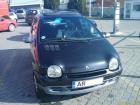Renault Twingo1986tw_pro1.jpg ( Size: 10.26k )
Number of downloads: 124 The story begins with the initiation of the first VBG (Véhicule Bas de Gamme) project W-60. The idea is to design a multi-purpose minivan successor to the R4. An internal battle starts against another Renault project by Gandini (the designer of the Lamborghini Countach).
1988tw_pro2.JPG ( Size: 12.8k )
Number of downloads: 121 Renault's new management, under Raymond Lévy, decides that the project will continue. It is renamed ("X-60") in order to confuse competitors and supervision is handed to Patrick Le Quément with a tiny 3,5 billion Francs ($700 million) budget.
October 5th 1992tw_pict.gif ( Size: 39.67k )
Number of downloads: 119 Renault Twingo's official birth at the 1992 Paris Mondial AutoShow. Already 2240 reservation forms are signed. Twingo's unseen colours, line, and modular interior are the reason for it's immediate success.
tw_new.gif ( Size: 15.67k )
Number of downloads: 123 paris92.jpg ( Size: 41.54k )
Number of downloads: 118 In addition to Twingo's special look, its interior is what makes it's originality. Twingo is the shortest car of its category, but its interior is the largest . It is probably the smallest minivan/MPV with a special philosophy : "une voiture à vivre". Its other main features are the huge digital LCD in the middle of the dashboard and the famous modular back seats :
- Slide them back and you have more leg space than in a Safrane. Only the trunk gets smaller.
- Slide them forward, and you have more space for luggage than in any other car of it's size. And there's still enough room for small passengers.
- With both front and back seats tilted backwards, Twingo's interior turns into a double bed.
- Completely fold the seats and the Twingo turns into a delivery van.
A | Total Length | 3,43m |
G | Total Width | 1,63m |
H | Height | 1,42m |
. | Weight | 815 to 850 Kg |
. | Modular Trunk | 168 to 1096dm3 |
. | Petrol/Gas tank | 40 litres |
. | Aerodynamics | Cx 0,35/SCx 0,695 |
"Cleon" C3G Engine |
(All models before july 1996) |
Engine | 4cyl., 1239cc |
0-60mph - 0-100km/h | 14.0 sec |
1/4 Mile - 400m | 18.9 sec |
Top Speed | 93mph - 151km/h |
Power | 55 bhp @ 5300 rpm |
Torque | 66lb-ft - 90Nm @ 2800 rpm |
Injection | monopoint |
Transmission | Front WD - 5 sp. manual or semi-auto (Easy) |
55mph - 90km/h | 46 mpg - 5,1 l/100km |
City | 32 mpg - 7,4 l/100km |
New D7F Engine |
(Since july 1996) |
Engine | 4cyl., 1149cc, 8V |
0-60mph - 0-100km/h | 13.4 sec (Easy:14,4 Matic:16,4) |
1/4 Mile - 400m | 18.8 sec (Easy:19,8 Matic:20,5) |
Top Speed | 94mph - 150km/h |
Power | 60 bhp @ 5250 rpm |
Torque | 93Nm-2500tr/mn |
Injection | Sequential Multipoint |
Transmission | Front WD - 5 sp. manual or semi-auto (Easy) or 3 sp. auto. ('Matic) |
55mph - 90km/h | 49 mpg - 4,8 l/100km |
City | 36 mpg - 6,5 l/100km |
New D4F Engine |
(Since december 2000) |
Engine | 4cyl., 1149cc, 16V |
0-60mph - 0-100km/h | 11.7 sec |
1/4 Mile - 400m | 33.7 sec |
Top Speed | 170km/h |
Power | 75 bhp @ 5500 rpm |
Torque | 105Nm-3500tr/mn |
Injection | Sequential Multipoint |
Transmission | Front WD - 5 sp. manual or semi-auto (Easy) or 3 sp. auto. ('Matic) |
55mph - 90km/h | 4,9 l/100km |
City | 7,5 l/100km |
SigurantaLinks :
-
Crash test Euroncap(2003)
-
Twingo crash test with a Laguna : crashtest.mov, 445 Kb
Despite being only 3.43 m. long, the Twingo therefore offers a high level of safety, even in collisions with vehicles of significantly greater weight.
The Twingo 2 is equipped with a reinforced lower structure with longerons of greater thickness and different cross-section, a thicker floor panel, stiffeners for the tunnel (forward section) and the sill sections (of omega section), and steering column support flanges. The upper part of the structure has also been modified with stiffeners for the front inner wings and the door frames (of omega section), and inner panels for the front pillars and the rear quarters. Altogether, Twingo uses an extra 30 kg of high-strength steel in its structure.
The Twingo 2 is also equipped with high performance occupant retention systems to offset the effects of the greater deceleration resulting from the greater stiffness of the structure. As a new feature at this market level, the Twingo 2 is equipped with the Renault SRP (System for Restraint and Protection) with programmed restraint airbags, safety belt pretensioners, load limiters for the front and rear seats, and close-contact head restraints with curved runners.
twingosafetyqw0.pngThanks to a control valve which allows pressure in the airbag to be adjusted during the deceleration phase, the programmed restraint airbag achieves levels of energy absorption and damped movement impossible with conventional airbags. In addition, this airbag protects and damps movement of both head and chest. During deceleration, the load exerted on the latter by the belt is reduced to only 400 kg, compared with the usual 900 kg. In this way the Twingo achieves a performance unique in its market segment.
This system can be completed by specifying combined head and chest side airbags, another completely new feature for a car in this class. Equipped with control valves to regulate inflation pressure, the bags provide improved protection for both head and chest compared with conventional side airbags.
The future (2007?)"Twingo Concept", Mondial de Paris, October 2005,
Twingo Conceptsursa: internet
This post has been edited by cmandrei: 17 Aug 2017, 10:17 



 7 Feb 2007, 17:04
7 Feb 2007, 17:04

 5 Nov 2010, 08:59
5 Nov 2010, 08:59

 30 Mar 2011, 03:54
30 Mar 2011, 03:54
 30 Dec 2012, 14:53
30 Dec 2012, 14:53





